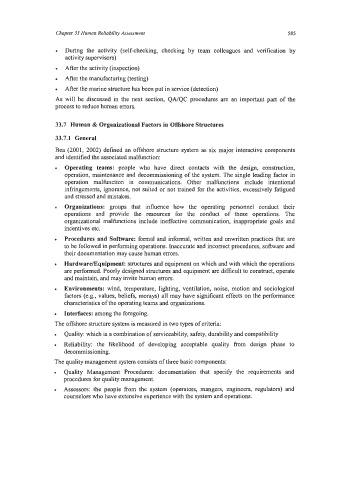Page 609 - Marine Structural Design
P. 609
Chapter 33 Human Reliability Assessment 585
During the activity (self-checking, checking by team colleagues and verification by
activity supervisors)
After the activity (inspection)
After the manufacturing (testing)
After the marine structure has been put in service (detection)
As will be discussed in the next section, QMQC procedures are an important part of the
process to reduce human errors.
33.7 Human & Organizational Factors in Offshore Structures
33.7.1 General
Bea (2001, 2002) defined an offshore structure system as six major interactive components
and identified the associated malhction:
Operating teams: people who have direct contacts with the design, construction,
operation, maintenance and decommissioning of the system. The single leading factor in
operation malfunction is communications. Other malfunctions include intentional
infringements, ignorance, not suited or not trained for the activities, excessiveiy fatigued
and stressed and mistakes.
Organizations: groups that influence how the operating personnel conduct their
operations and provide the resources for the conduct of these operations. The
organizational malfunctions include ineffective communication, inappropriate goals and
incentives etc.
Procedures and Software: formal and informal, written and unwritten practices that are
to be followed in performing operations. Inaccurate and incorrect procedures, software and
their documentation may cause human errors.
Hardwaremquipment: structures and equipment on which and with which the operations
are performed. Poorly designed structures and equipment are difficult to construct, operate
and maintain, and may invite human errors.
Environments: wind, temperature, lighting, ventilation, noise, motion and sociological
factors (e.g., values, beliefs, morays) all may have significant effects on the performance
characteristics of the operating teams and organizations.
Interfaces: among the foregoing.
The offshore structure system is measured in two types of criteria:
Quality: which is a combination of serviceability, safety, durability and compatibility
Reliability: the likelihood of developing acceptable quality from design phase to
decommissioning.
The quality management system consists of three basic components:
Quality Management Procedures: documentation that specify the requirements and
procedures for quality management.
Assessors: the people from the system (operators, mangers, engineers, regulators) and
counselors who have extensive experience with the system and operations.

